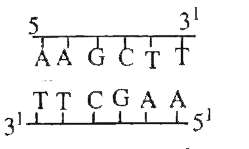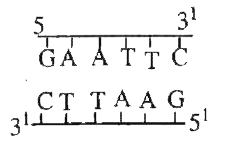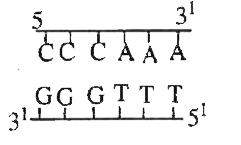The restriction enzyme EcoRI recognize following palindrome sequence.




The correct Answer is:C
To answer the question regarding the recognition palindromic sequence for the restriction enzyme EcoRI, we can follow these steps:
1. Understanding Palindromic Sequences:
- A palindromic sequence in DNA is a sequence that reads the same forward and backward on complementary strands. This is crucial for restriction enzymes as they recognize these sequences to cut DNA.
2. Identifying the EcoRI Recognition Sequence:
- The specific recognition sequence for the restriction enzyme EcoRI is known to be "GAATTC".
3. Writing the Complementary Strand:
- The complementary strand to "GAATTC" would be "CTTAAG". This is because:
- Guanine (G) pairs with Cytosine (C)
- Adenine (A) pairs with Thymine (T)
4. Visualizing the Cut Site:
- EcoRI cuts between the G and A on both strands. Therefore, the cut occurs:
- On the top strand: G|AATTC
- On the bottom strand: CTT|AAG
5. Finding the Correct Option:
- If provided with multiple-choice options, we would look for the one that contains the sequence "GAATTC" on one strand and "CTTAAG" on the complementary strand.
Final Answer:
The recognition palindromic sequence for the restriction enzyme EcoRI is "GAATTC" on one strand and "CTTAAG" on the complementary strand.
---
- A palindromic sequence in DNA is a sequence that reads the same forward and backward on complementary strands. This is crucial for restriction enzymes as they recognize these sequences to cut DNA.
- The specific recognition sequence for the restriction enzyme EcoRI is known to be "GAATTC".
- The complementary strand to "GAATTC" would be "CTTAAG". This is because:
- Guanine (G) pairs with Cytosine (C)
- Adenine (A) pairs with Thymine (T)
- EcoRI cuts between the G and A on both strands. Therefore, the cut occurs:
- On the top strand: G|AATTC
- On the bottom strand: CTT|AAG
- If provided with multiple-choice options, we would look for the one that contains the sequence "GAATTC" on one strand and "CTTAAG" on the complementary strand.
The recognition palindromic sequence for the restriction enzyme EcoRI is "GAATTC" on one strand and "CTTAAG" on the complementary strand.
Topper's Solved these Questions
- PRINCIPLES AND PROCESSES BOOK - AAKASH SERIESCHAPTER - PRINCIPLES AND PROCESSES EXERCISE - Exercise - III (Previous AIPMT/NEET Questions)
26 Videos
- PRINCIPLES AND PROCESSES BOOK - AAKASH SERIESCHAPTER - PRINCIPLES AND PROCESSES EXERCISE - Exercise-I (More than one options correct)
23 Videos
- PLANT GROWTH AND DEVELOPMENT BOOK - AAKASH SERIESCHAPTER - PLANT GROWTH AND DEVELOPMENT EXERCISE - EXERCISE -III (PREVIOUS AIPMT/NEET QUESTIONS)
27 Videos
- PRINCIPLES OF INHERITANCE AND VARIATIONBOOK - AAKASH SERIESCHAPTER - PRINCIPLES OF INHERITANCE AND VARIATIONEXERCISE - EXERCISE -III (Previous AIPMT /NEET Questions)
37 Videos
Similar Questions
Knowledge Check
Which of the following statements does not hold true for restriction enzyme?
(a) It recongnises a palindromic nucleotide sequence
(b) It is an endonuclease.
(c) It is isolated from viruses
(d) It produces the same kind of sticky ends in different DNA moleculesAIt recongnises a palindromic nucleotide sequenceBIt is an endonuclease.CIt is isolated from virusesDIt produces the same kind of sticky ends in different DNA molecules
Restriction enzymes
View SolutionRestriction enzymes are
View SolutionRestriction enzymes are :
View SolutionType - II restriction enzymes
View SolutionWhich of the following is a palindromic sequence ?
View SolutionAssertion : Restriction enzymes recongise palindromic sequences.
Reason : Palindromic sequences read same in both directions of the two strand.
View SolutionRead the following statements and choose the option with incorrect statements. (a) Restriction enzymes are obtained from prokaryotes. (b) Restriction endonucleases cut DNA strands by breaking hydrogen bonds at specific points. (c) More than 230 restriction enzymes have been isolated from more than 900 strains of bacteria. (d) Each restriction enzyme recognizes a specific palindromic nucleotide sequence in DNA.
View Solution
